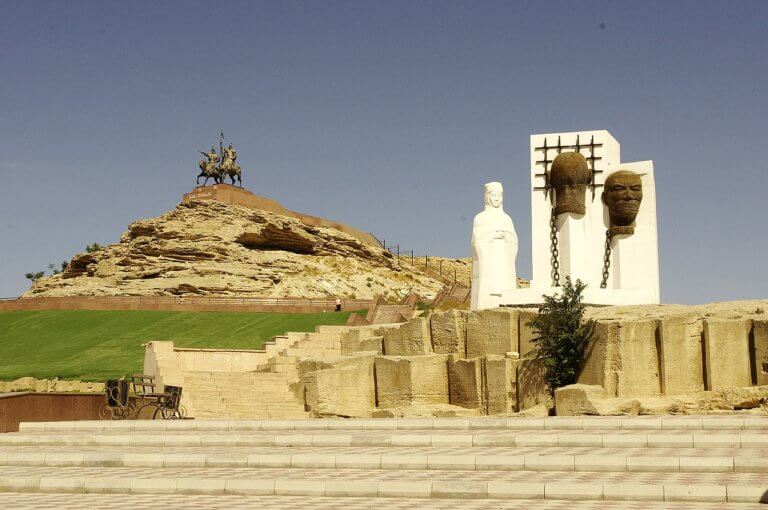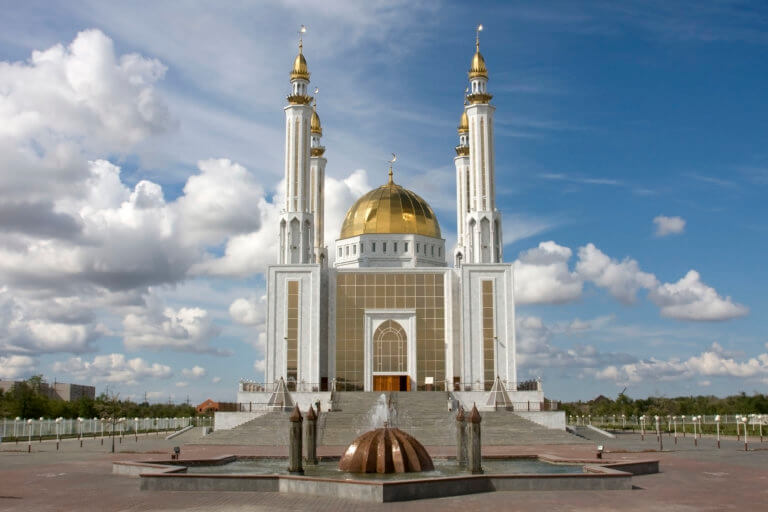
Aktau
Aktau serves as a perfect starting point for journeys into the Ustyurt and the broader Mangystau Region. Its strategic location on the Caspian Sea, coupled
At the northern edge of the Ryn Desert is Kamysh-Samara. The 60km x 100km plain was once home to at least a dozen lakes, with Aralsor – the largest one – measuring 13km wide. Today, many of the lakes’ water levels have decreased significantly and turned into dry salt pans. However, in the spring of 2024, the Kazakh state enterprise Kazvodkhoz diverted 80 million cubic metres of flood water from Russia into the region, replenishing some areas that hadn’t seen water for the last 20 years.
The decline of Kamysh-Samara’s lakes is due to a combination of a drying climate and upstream diversions of its two feeder rivers, the Maly and Bolshoy Uzen, to reservoirs. Despite this, the area’s remaining water sources remain a popular spot for a host of birdlife, such as curlews, terns, turukhtans, and grebes.
Little is published about the region in modern times, which is surprising given its size. Askar Isabekov’s richly illustrated 2017 trip report discussing birds in Kamysh-Samara and Vladislav Chistyakov’s video and photo story covering his wild off-road motorcycling trip offer the most detailed look at this little-known corner of Kazakhstan.
In January 1834, Dr F. Gœbel ventured with his colleagues, Dr C. Claus and Mr A. Bergmann, from Tartu, Estonia to examine the Lower Volga and western Kazakhstan’s salt lakes and salt-tolerant plants. At the time, plants growing in highly saline environments were the primary source of soda ash. The inorganic compound (aka sodium carbonate) was used for manufacturing dry soap powders and glass, water softening, and cooking. Their aim was to record plant distribution and analyse lake water chemical composition.
After a two-month wait in Saratov, Russia, for the arrival of spring, they ventured south through the Pontic-Caspian Steppe to Kamyshin, on the Volga’s right bank. From here, Gœbel and his colleagues caught a ferry across the river to Nikolayevsk, which sits at the edge of the Caspian Lowland. Ukrainian settlers established the town in the 18th century for transporting salt from Lake Elton, 120km to the south-east and Gœbel’s next waypoint.
Gœbel’s journey to Elton took him through flat, sandy, and willow-covered lands, outposts where he met Tatars from Kazan trading with local Kazakhs, and to the salty Lake Bulukhta. Before leaving Elton for Kamysh-Samara – less than 100km east – he stopped in Khan Ordasy village to stay a few nights at Zhangir-Kerey Khan’s wooden palace, who at the time was the Bukey Horde’s leader.
The final stretch to Kamysh-Samara was off the beaten track. They navigated their way by compass and watch through winding valleys and over sandy hills, and rolling an odometer as they went. Once there, Gœbel observed natural canals connecting a dozen lake-filled basins with swampy, reed-covered shores, and small salt lakes “looking like cold glittering plains of ice amidst the green and blooming soil.”
He spent the remainder of his trip in western Kazakhstan roaming around the countryside for a few months collecting samples in places such as Inder Lake, Atyrau, Saraishyk, the Ural River, and a few islands in the Caspian Sea. His report in the Royal Geographical Society’s journal, Journey through the Steppes of Southern Russia, covers the trip in detail and offers intriguing observations of the landscapes, ecology and people encountered.
Unless you have an off-road vehicle, the only way to get to Kamysh-Samara is on the R-97 road, which links to the A-28 Atyrau–Oral main road. For accommodation, head to the Novaya Kazanka or Khan Ordasy villages, on the southern edge of the lakes. The only chance of finding accommodation in the interior of Kamysh-Samara is most likely Saralzhin village, which is situated north of the R-97 and surrounded by half a dozen dried-up lakes.
Kamysh-Samara (Qamyş-Samara/Камыш-Самара): 49.2221, 48.4962
Aralsor Lake (Aralsor Kölı/Озеро Аралсор): 49.0743, 48.1852
Kishi Uzen/Maly Uzen (Kışı Özen/Малый Узень): 49.3560, 49.2043
Ulken Uzen/Bolshoy Uzen (Ülken Özen/Большой Узень): 49.5125, 49.7249
Novaya Kazanka Village (Jañaqazan/ Новая Казанка): 48.9323, 49.6047
Khan Ordasy Village (Han Ordasy/Хан Ордасы): 48.7692, 47.4314
Saralzhin Village (Saraljyñ/Саралжин): 49.1715, 48.9065
1:1mil Soviet map of western Kazakhstan, with Kamysh-Samara’s tadpole-like Aralsor Lake pictured in the bottom-left quarter.
1:200k Soviet map of Kamysh-Samara, with the bright blue Aralsor Lake centre-left. The Ryn Desert is in the bottom half.

Aktau serves as a perfect starting point for journeys into the Ustyurt and the broader Mangystau Region. Its strategic location on the Caspian Sea, coupled

Perched on the western tip of the Tub-Karagan Peninsula is the city of Fort Shevchenko and its satellite port town of Bautino. It’s the Mangystau

Aktobe is on the western end of the Kazakh Steppe, less than 100km from the Russian border. As the capital city of the Aktobe Region,
Copyright © Planet Esoterica, 2024. No part of this site, www.planetesoterica.com, may be reproduced in whole or in part in any manner without the permission of the copyright owner. All rights reserved.
Made with 